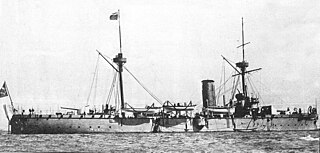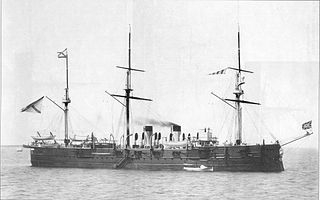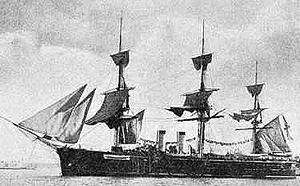Design and description
Originally classified as armored corvettes, the General-Admirals were redesignated as semi-armored frigates on 24 March 1875. They were laid out as central battery ironclads with the armament concentrated amidships. [2]
The General-Admiral-class ships were 285 feet 10 inches (87.1 m) long overall. They had a beam of 48 feet (14.6 m) and a draft of 24 feet 5 inches (7.4 m). The ships were designed to displace 4,604 long tons (4,678 t), but displaced 5,031 long tons (5,112 t) as built, an increase of over 400 long tons (410 t). The iron-hulled ships were not fitted with a ram and their crew numbered approximately 482 officers and men. [2]
The ships had a vertical compound steam engine driving a single two-bladed, 20-foot-6-inch (6.25 m) propeller, using steam provided by cylindrical boilers. The number of boilers differed between the sisters. General-Admiral had five that generated a working pressure of 60 psi (414 kPa ; 4 kgf/cm2 ) so that the engine produced 4,772 indicated horsepower (3,558 kW). This gave her during a maximum speed around 12.3 knots (22.8 km/h; 14.2 mph) during her sea trials. Gerzog Edinburgski had four boilers and her engine made 5,590 ihp (4,170 kW) that propelled her at 11.5 knots (21.3 km/h; 13.2 mph). [3]
The General-Admiral class carried a maximum of 1,000 long tons (1,000 t) of coal which gave them an economical range of 5,900 nautical miles (10,900 km; 6,800 mi) at a speed of 10 knots (19 km/h; 12 mph). They were ship-rigged with three masts. To reduce drag while under sail, the single funnel was retractable and the propeller could be hoisted into the hull. [4]
The sisters armament were four 8-inch (203 mm), two 6-inch (152 mm) rifled breech-loading guns (RBL), and four 1.75-inch (44 mm) early masnine-gun likes Engstrom guns.
The ships had a complete waterline belt of wrought iron that ranged in thickness from 6 inches amidships to 5 inches (127 mm) at the ends of the ships. The armor had a total height of 7 feet 1 inch (2.15 m), of which 5 feet 1 inch (1.55 m) was below the waterline. The central battery was also protected by 6-inch armor plates. [5]
Service
General-Admiral had was blown ashore during a heavy storm at Kronstadt in 1875, shortly after being completed. [6] She did not participate in the Russo-Turkish War of 1877–78 and made one cruise in the Pacific in the early 1880s. The ship spent 1884–85 in the Mediterranean before beginning a refit in 1886 during which she was partially re-boilered. General-Admiral had her boilers replaced, her funnel was replaced by two non-retractable funnels, and a fixed propeller was installed in 1892. The ship was reclassified as a 1st-class cruiser on 13 February 1892 and participated the Columibian Naval Review in Hampton Roads, Virginia, the following year. Afterwards she became a training ship. She became a school ship in 1906 and her armament was reduced accordingly. [8]
Gerzog Edinburgski was initially assigned to the Baltic Fleet, but made a lengthy Pacific cruise in 1881–84. She was refitted about 1890 in the same type as her sister's 1892 refit, although her engine and boilers were replaced in 1897. The ship became a training ship for petty officers and was formally reclassified as a school ship like her sister in 1906. [9]
The sisters were converted into minelayers in 1908–11 and renamed after lakes near Saint Petersburg, General-Admiral became Narova and Gerzog Edinburgski was renamed Onega. Their rigging was reduced to pole masts, their armament was reduced to four 75-millimeter (3.0 in) guns, and they could carry 600–800 mines. They both participated in numerous minelaying missions in the early years of World War I, but Onega was hulked in 1915 as Blokshiv No. 9 and became a mine storage ship in Helsinki. Narova, however, continued to lay mines throughout the war. The Treaty of Brest-Litovsk required the Soviets to evacuate their base in March 1918 or have them interned by newly independent Finland, even though the Gulf of Finland was still frozen over. The sisters were not included in the initial group of evacuated ships and were only permitted to leave in May for Kronstadt after lengthy negotiations with the Germans. Narova's crew joined the Soviets and she was used to mine the approaches to Petrograd later that year against the British forces operating in the Gulf of Finland against the Soviets. She was renamed Dvadsatpyatavo Oktyabrya (25 October) in 1922 [10]
The ultimate fates of the sisters are not exactly known. Blokshiv No. 9 was apparently broken up in the 1920s while Dvadsatpyatavo Oktyabrya became a mine storage hulk in 1938 before being sunk as a breakwater in the Neva River around 1959. [6]

HMS Manchester was a Town-class light cruiser built for the Royal Navy in the late 1930s, one of three ships in the Gloucester subclass. Completed in 1938, she was initially deployed with the East Indies Station and had a relatively short but active career. When World War II began in September 1939, the cruiser began escorting convoys in the Indian Ocean until she was ordered home two months later. In late December Manchester began conducting patrols in the Norwegian Sea enforcing the blockade of Germany. Beginning in April 1940 the ship played a minor role in the Norwegian Campaign, mostly escorting convoys. She was assigned to anti-invasion duties in May–November in between refits.

HMS Black Prince was the third ship of that name to serve with the Royal Navy. She was the world's second ocean-going, iron-hulled, armoured warship, following her sister ship, HMS Warrior. For a brief period the two Warrior-class ironclads were the most powerful warships in the world, being virtually impregnable to the naval guns of the time. Rapid advances in naval technology left Black Prince and her sister obsolete within a short time, however, and she spent more time in reserve and training roles than in first-line service.

HMS Royal Oak was a Prince Consort-class armoured frigate built for the Royal Navy in the 1860s. The lead ship of her class, she is sometimes described as a half-sister to the other three ships because of her different engine and boiler arrangements. Like her sisters, she was converted into an ironclad from a wooden ship of the line that was still under construction.
The Admiral-class battlecruisers were to have been a class of four British Royal Navy battlecruisers built near the end of World War I. Their design began as an improved version of the Queen Elizabeth-class battleships, but it was recast as a battlecruiser after Admiral John Jellicoe, commander of the Grand Fleet, pointed out that there was no real need for more battleships, but that a number of German battlecruisers had been laid down that were superior to the bulk of the Grand Fleet's battlecruisers and the design was revised to counter these. The class was to have consisted of HMS Hood, Anson, Howe, and Rodney — all names of famous admirals — but the other three ships were suspended as the material and labour required to complete them was needed for higher-priority merchantmen and escort vessels. Their designs were updated to incorporate the lessons from the Battle of Jutland, but the Admiralty eventually decided that it was better to begin again with a clean-slate design so they were cancelled in 1919. No more battlecruisers would be built due to the arms limitations agreements of the interbellum.

Tokiwa (常盤) was the second and last Asama-class armored cruiser built for the Imperial Japanese Navy (IJN) in the late 1890s. As Japan lacked the industrial capacity to build such warships herself, the ship was built in Britain. She played minor roles in the Boxer Rebellion of 1900 and World War I, but was very active during the Russo-Japanese War of 1904–05 where she participated in the Battle of Port Arthur, the Battle off Ulsan, and the Battle of Tsushima. After the war she was sometimes used as a training ship for naval cadets.

The Petropavlovsk class, sometimes referred to as the Poltava class, was a group of three pre-dreadnought battleships built for the Imperial Russian Navy during the 1890s. They were transferred to the Pacific Squadron shortly after their completion in 1899–1900 and were based at Port Arthur before the start of the Russo-Japanese War of 1904–1905. All three ships participated in the Battle of Port Arthur on the second day of the war. Petropavlovsk sank two months after the war began after striking one or more mines laid by the Japanese. Her two sister ships, Sevastopol and Poltava, took part in the Battle of the Yellow Sea in August 1904 and were sunk or scuttled during the final stages of the siege of Port Arthur in early 1905.

HMS Swiftsure, originally known as Constitución, was the lead ship of the Swiftsure-class pre-dreadnought battleships. The ship was ordered by the Chilean Navy, but she was purchased by the United Kingdom as part of ending the Argentine–Chilean naval arms race. In British service, Swiftsure was initially assigned to the Home Fleet and Channel Fleets before being transferred to the Mediterranean Fleet in 1909. She rejoined Home Fleet in 1912 and was transferred to the East Indies Station in 1913, to act as its flagship.

Rossia was an armored cruiser of the Imperial Russian Navy built in the 1890s. She was designed as a long-range commerce raider and served as such during the Russo-Japanese War of 1904–05. She was based in Vladivostok when the war broke out and made a number of sorties in search of Japanese shipping in the early months of the war without much success.

Petr Velikiy was an ironclad turret ship built for the Imperial Russian Navy during the 1870s. Her engines and boilers were defective, but were not replaced until 1881. The ship made a cruise to the Mediterranean after they were installed, and before returning to the Baltic Fleet, where she remained for the rest of her career. She did not, like the rest of the Baltic Fleet, participate in the Russo-Turkish War of 1877–1878. Petr Veliky was deemed obsolete by the late 1890s, but she was not ordered to be converted into a gunnery training ship until 1903.

General-Admiral was the lead ship of her class of armored cruisers built for the Imperial Russian Navy in the early 1870s. She is generally considered as the first true armored cruiser.

Jingyuan was a cruiser built for the Imperial Chinese Navy. She was built by Armstrong Whitworth in Elswick, England. She was one of two Zhiyuen-class protected cruisers built, alongside her sister ship Zhiyuen. Jingyuan was armed with a smaller number of large sized naval guns, as opposed to later ships of this type which carried a larger number of smaller guns. This was because the medium-calibre quick-firing gun had yet to be introduced, thus a warship's firepower at the time was largely a function of individual shell weight rather than volume of fire.

The Satsuma class was a pair of semi-dreadnought battleships built for the Imperial Japanese Navy (IJN) in the first decade of the 20th century. They were the first battleships to be built in Japan and marked a transitional stage between the pre-dreadnought and true dreadnought designs. They saw no combat during World War I, although Satsuma led a squadron that occupied several German colonies in the Pacific Ocean in 1914. Both ships were disarmed and expended as targets in 1922–1924 in accordance with the terms of the Washington Naval Treaty of 1922.

The Ibuki class, also called the Kurama class, was a ship class of two large armoured cruisers built for the Imperial Japanese Navy after the Russo-Japanese War of 1904–1905. These ships reflected Japanese experiences during that war as they were designed to fight side-by-side with battleships and were given an armament equal to, or superior to existing Japanese battleships. The development of the battlecruiser the year before Ibuki was completed made her and her sister ship Kurama obsolete before they were completed because the foreign battlecruisers were much more heavily armed and faster.

Amiral Charner was an armored cruiser built for the French Navy in the 1890s, the name ship of her class. She spent most of her career in the Mediterranean, although she was sent to China during the Boxer Rebellion of 1900–01. The ship was assigned to the International Squadron off the island of Crete during 1897-1898 revolt there and the Greco-Turkish War of 1897 to protect French interests and citizens. Amiral Charner spent most of the first decade of the 20th century as a training ship or in reserve. The ship was recommissioned when World War I began in 1914 and escorted convoys for several months before she was assigned to the Eastern Mediterranean to blockade the Ottoman-controlled coast. During this time, she helped to rescue several thousand Armenians from Syria during the Armenian genocide of 1915. Amiral Charner was sunk in early 1916 by a German submarine, with only a single survivor rescued.

The Russian cruiser Minin was an armored cruiser built for the Imperial Russian Navy during the 1860s and 1870s. She was renamed Ladoga in 1909 when converted to a minelayer. The ship was sunk in 1915 when she struck a mine laid by a German submarine in the Baltic Sea.

The Russian ironclad Kniaz Pozharsky was an iron-hulled armored frigate built for the Imperial Russian Navy during the 1860s. She was the first Russian armored ship to leave European waters when she cruised the Pacific Ocean in 1873–75. The ship did not participate in the Russo-Turkish War of 1877–78, and remained in the Baltic Sea until 1879–80, when she made another cruise to the Pacific. Kniaz Pozharsky was assigned to the Baltic Fleet for the rest of her career. She mainly served as a training ship after her refit in 1885 until she was hulked in 1909 and probably scrapped in 1911.
The Briton class was a group of three wooden screw corvettes built for the Royal Navy in the late 1860s. All three ships of the class only served overseas during their brief service lives. Between them, they were assigned to the China, East Indies, African, North American, and the Pacific Stations. All three were regarded as obsolete 15 years after they were completed, and they were sold in 1886–87.

Bronenosets was a Uragan-class monitor built for the Imperial Russian Navy in the mid-1860s. The design was based on the American Passaic-class monitor, but was modified to suit Russian engines, guns and construction techniques. The ship was only active when the Gulf of Finland was not frozen, but very little is known about her service. She was stricken in 1900 from the Navy List, converted into a coal barge in 1903 and renamed Barzha No. 324. The ship was lost in a storm sometime during World War I.

Lava was an Uragan-class monitor built for the Imperial Russian Navy in the mid-1860s. The design was based on the American Passaic-class monitor, but was modified to suit Russian engines, guns and construction techniques. Spending her entire career with the Baltic Fleet, the ship was only active when the Gulf of Finland was not frozen, but very little is known about her service. She was struck from the Navy List in 1900, converted into a barracks ship in 1902 and then into a storage hulk for mines in 1912 and renamed Blokshiv No. 1. During World War I, she was converted into a hospital ship in 1916 and was then abandoned by the Soviets in Finland in 1918; the ship was probably later scrapped by the Finns around 1922.

Edinorog was one of 10 Uragan-class monitors built for the Imperial Russian Navy in the mid-1860s. The design was based on the American Passaic-class monitor, but was modified to suit Russian engines, guns and construction techniques. Spending her entire career with the Baltic Fleet, the ship was only active when the Gulf of Finland was not frozen, but very little is known about her service. She was struck from the Navy List in 1900, converted into a storage hulk for mines in 1912 and renamed Blokshiv No. 4. The ship survived World War II and was stricken in 1957, although her ultimate fate is unknown.


















